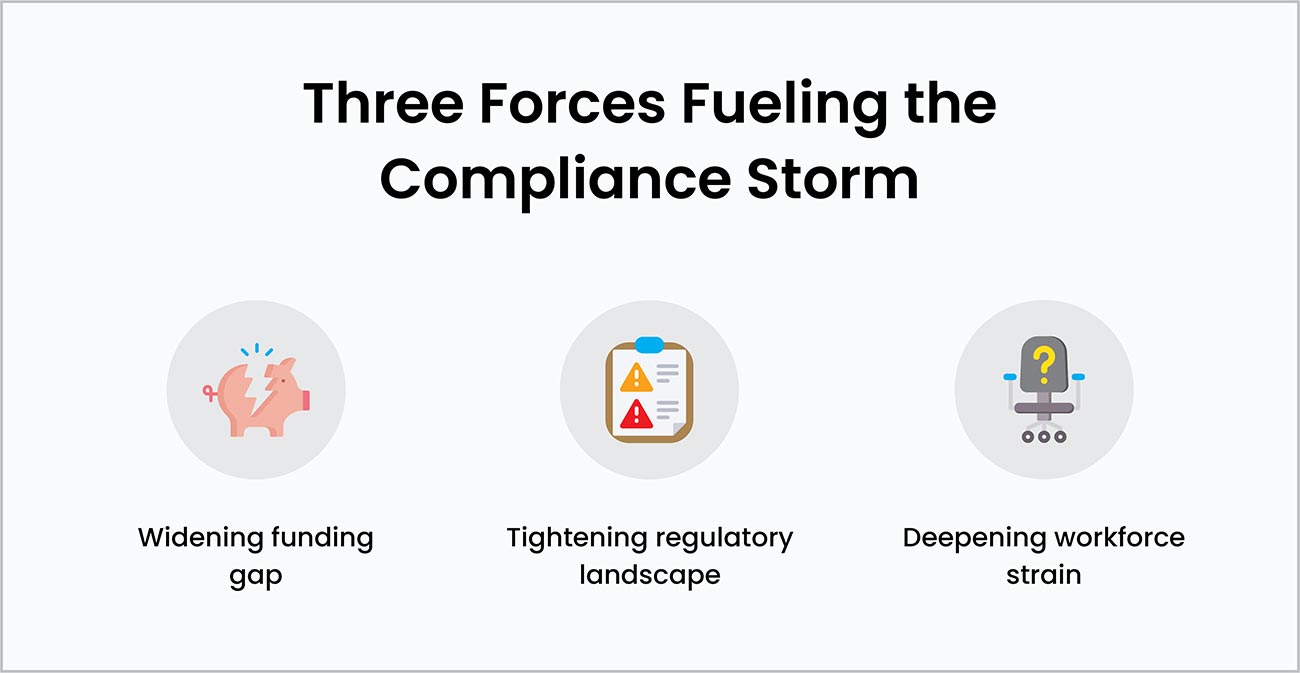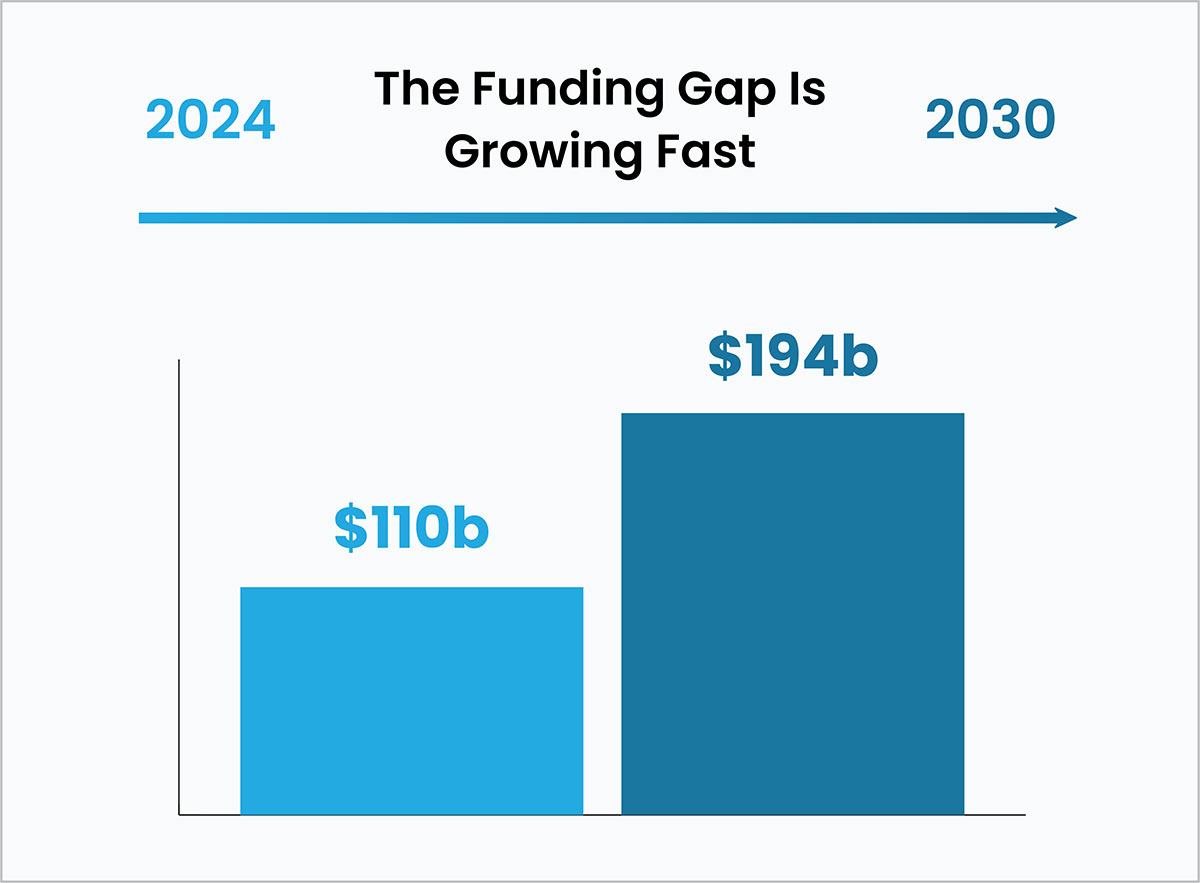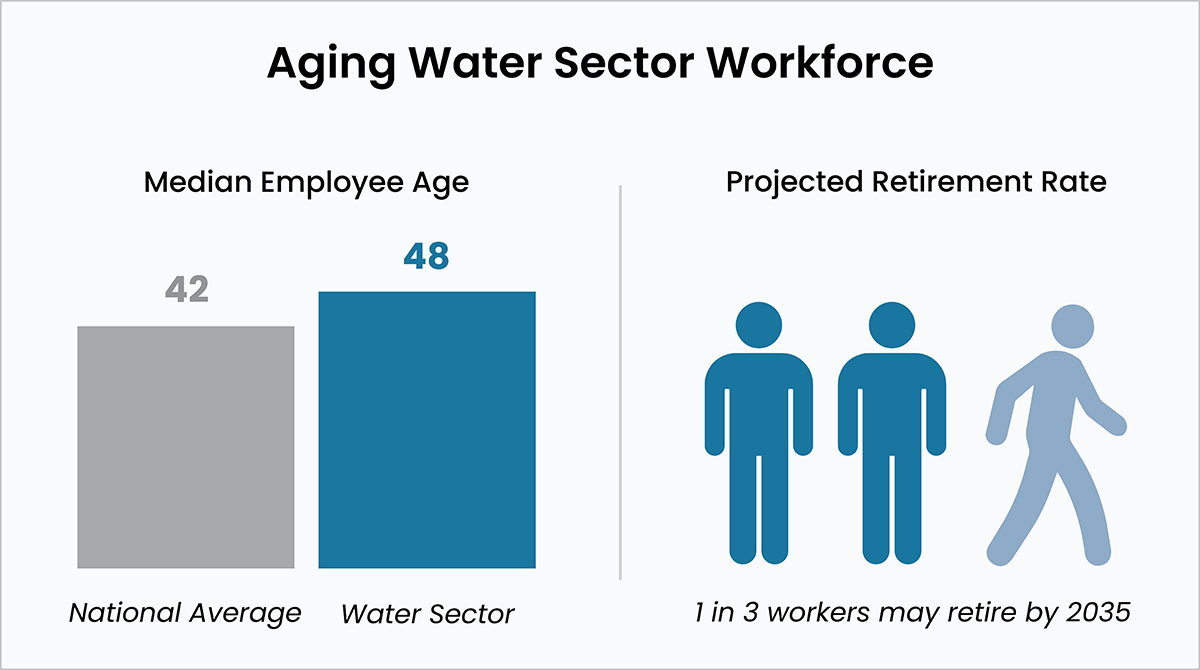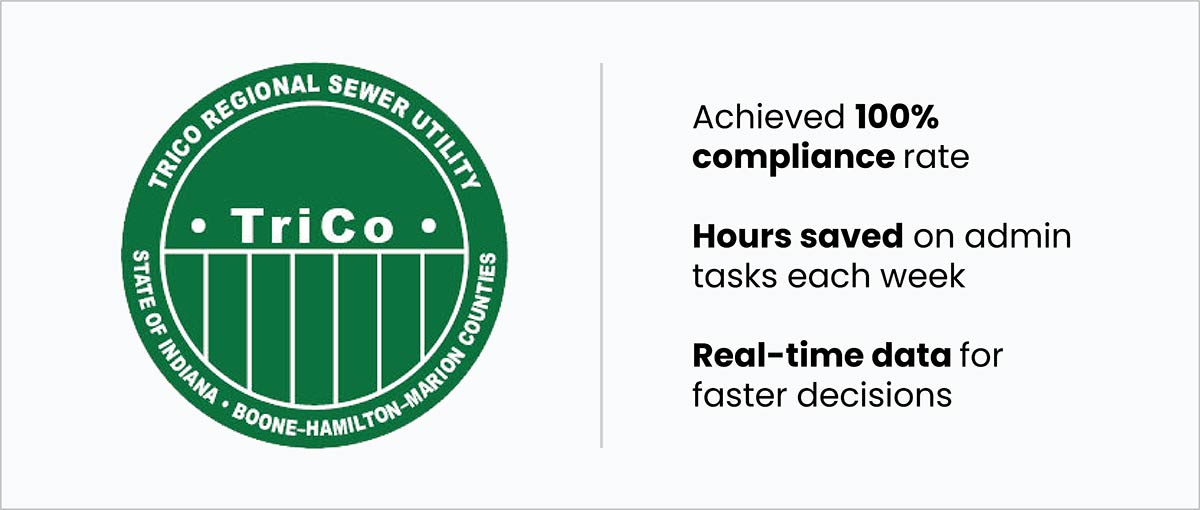Key takeaways
What you’ll learn in this article
- The pressure is coming from all sides. Programs are being asked to do more than their budgets, tools, and teams can support.
- Many teams are stuck in survival mode. Core tasks like inspections, surveys, and follow-ups are slipping — not from neglect, but from a lack of capacity.
- Institutional knowledge is walking out the door. As experienced staff retire, new team members are left catching up in systems that weren’t built to support them.
- Compliance is drifting into reactive mode. Teams are firefighting, and programs are more exposed to what’s coming next.
- Risk builds quietly. Missed records, unread reports, and growing backlogs chip away at program strength.
- The solution starts with rethinking the work. The right systems can reduce the manual load and help teams focus on what matters most.
What we’re hearing from the field
Compliance programs across the water and wastewater sector are under strain, with pressure coming from all sides.
Budgets are tight. Keeping up with regulations is getting harder. Experienced staff are stepping away, often with no one ready to replace them.
None of these challenges are new on their own. But together, they’re creating a perfect storm that’s testing the limits of already stretched programs.
To understand how teams are navigating it, we surveyed over 100 water and wastewater utility professionals and drew on years of experience working with compliance teams across the country.
What we heard was consistent. And increasingly urgent.
This article looks at what that pressure actually feels like, and how some teams are starting to adapt.
The system is reaching its limit
What used to be hard is now harder to hold together. And for many compliance teams, that pressure is coming from all directions.
These are the three most acute forces utility leaders are up against right now, and how they’re shaping the way compliance work gets done.

Economic pressure: The resource gap is widening
Tight budgets are nothing new for water and wastewater utilities. But this moment feels different. The gap between what compliance programs are expected to deliver and what current resources allow is widening fast.
Recent research shows water and wastewater utilities are facing a $110 billion annual funding shortfall — nearly 60% of what’s needed just to operate, maintain, and upgrade existing systems. And that gap is projected to grow to $194 billion by 2030.

Source: McKinsey & Company
Programs are forced to make tradeoffs
As aging infrastructure drives up maintenance costs and new regulations raise the bar, programs are forced into difficult tradeoffs. Preventive tasks get pushed. System upgrades stay on wishlists. Even well-resourced programs told us they’re scrambling:
If your situation is anything like many of the industry pros we have spoken, your program is becoming more reactive — not because you’re not trying, but because the system just isn’t built for this volume.
And it’s not just a budget issue. It’s a structural mismatch between rising demands and shrinking capacity: more complexity, higher expectations, and fewer people to handle it.
For many compliance programs, it means entering what one respondent described as “survival mode.”
Regulatory pressure: Staying compliant is getting harder
When we asked industry pros to describe what survival mode looked like for them, the details varied. But the outcome was always the same.
Firefighting becomes the default. The goal shifts from improving workflows to simply keeping things from slipping through the cracks.
And for a lot of programs, those cracks are already visible.
Many teams are falling behind on mandates that have been in the books for a long time. And if you’re stretched thin, the thought of a new wave of requirements probably feels even more daunting.
Foundational tasks are falling behind
It’s the foundational tasks that erode quietly under pressure. We heard the same patterns again and again: surveys left undone, inspections delayed, violation notices going out weeks late.
In California, backflow teams are required to conduct surveys of every service connection to assess for cross-connections—a fundamental public health safeguard. However, in practice, many teams simply don’t have the staff or time to keep up.
That’s not an outlier — it’s a reflection of broader system strain. And this strain is happening before the next round of regulations fully lands on your desk.
New PFAS standards are forcing rapid investment in detection, treatment, and reporting. The revised Lead and Copper Rule is driving stricter inventory and remediation requirements.
Risk builds slowly
In that widening gap between expectations and capacity, the real risk doesn’t arrive all at once. It creeps in as workflows fray, visibility dims, and water compliance management becomes reactive by default. This drift toward reactive compliance is one of the most urgent risks facing utility programs.
Workforce pressure: Institutional knowledge is walking out the door
The pressure on compliance teams isn’t just operational — it’s generational. Long-tenured staff are retiring, often without clear successors.
And when they go, they take more than manpower. They take the context behind every workflow, the trust they’ve built with customers, and the kind of hard-won know-how that keeps a compliance program running.
This isn’t a tomorrow problem. It’s already happening.
In our survey, workforce transition and talent retention both ranked among the top five challenges. Nearly every team reported some form of staffing strain —from roles left unfilled for months to entire programs run by one or two people.
And it’s not likely to get easier anytime soon.
Roughly one-third of the water sector workforce is eligible to retire in the next decade, with a median employee age of 48 — six years older than the national average. Some estimates place the total projected workforce loss at 30–50% over the next ten years.

Source: US EPA
New hires are left playing catch-up
Meanwhile, new team members inherit siloed data, manual workflows, and growing backlogs from day one. Instead of stepping into stable systems with proper knowledge transfer, they’re playing catch-up in an environment where it’s already difficult to build momentum.
When everyone is struggling to keep pace, the problem compounds across every aspect of your program — from audits to follow-ups to program improvements.
The cost of just getting by
It’s tempting to treat these as three distinct challenges. But in practice, they don’t just overlap — they intensify each other.
Budget constraints lock in legacy tools that are no longer fit for purpose. Staffing gaps slow adaptation. Regulatory changes strain already fragile workflows.
Together, they’ve created a storm that’s been building for years. Now, it’s testing the limits of programs that are already well over capacity.
It doesn’t start with a crisis
It often starts with small slips:
- A missed follow-up, because no one on your team knew where the record lived
- A digital system sidelined, because there was no time for training
- A backlog of unread reports, until something escalates
Individually, they don’t feel catastrophic. But they add up. And all the while, the pressure continues to build on frontline workers trying to hold the system together.
This is the quiet risk you could be facing. Not a fine or a major headline.
Just the slow unraveling of a program held together by tools and workflows that weren’t built for the realities of compliance management today.
Here’s what progress looks like
If you’ve made it this far, chances are this all feels familiar: staffing gaps, budget pressure, regulatory strain. It’s a lot. And let’s be honest, this probably isn’t the first article you’d hand to a new team member.
But it’s not all doom and gloom.
While you can’t fix everything overnight, the right software system can help you improve your compliance rates fast. And yes, I’ll say the line: “do more with less.”
Now I know what you’re thinking. Here it comes, the pitch.
Don’t worry, I’m not going to start listing out features. But getting the right solution in place is probably the single most impactful change you can make in the shortest amount of time.
Real-world wins
The teams we work with are proof that practical solutions exist.
Take DeKalb County. Their backflow compliance team was spending 80 hours every week just handling paperwork. By automating these routine tasks, they’ve reclaimed those 80 hours and improved their reporting accuracy to over 90%.
Or TriCo Regional Sewer District, where FOG Manager Shaun Odom was managing 192 facilities using handwritten notes and Excel spreadsheets. “I was spending more time managing the paperwork than the program,” he told us. After implementing the right system, his team achieved 100% compliance while dramatically reducing administrative time.
We’re not saying software is the whole solution. It’s not. But these aren’t isolated examples. We’ve seen programs of all sizes massively reduce the administrative burden and improve their compliance rates.
You’ll still have to do the work, our system just makes sure it’s the work that actually matters.
Want to see what’s working for other teams?
If any of this sounds familiar, or if you’re looking at how the right software might help close some of these gaps, we’d love to show you what’s possible.
We work with water and wastewater programs across the country and have seen how incremental, practical changes can lead to real progress. If you’re curious how other teams are using SwiftComply to make that happen, we’d love to show you what that looks like.
No pressure. Just a chance to talk through what you’re trying to solve and see if we’re a good fit.









